V Edinburghu vystavili vzácný Kokoschkův obraz k 80. výročí konce 2. světové války v Evropě.
- Skotsko.co.uk

- May 7
- 4 min read
Updated: May 21
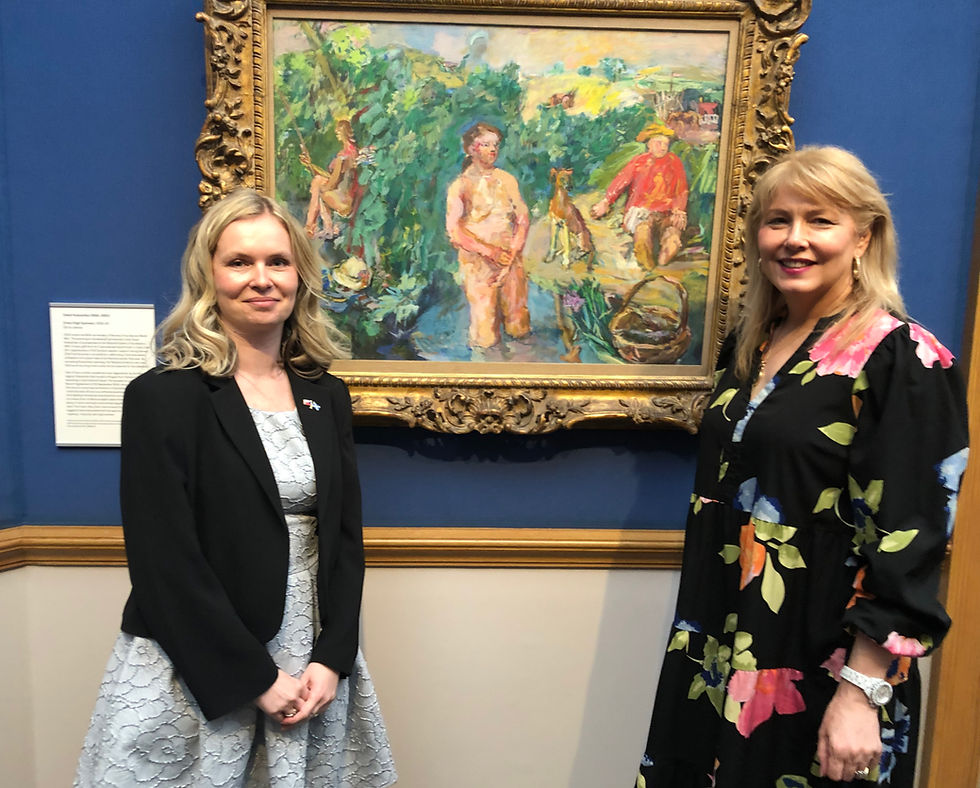
80. výročí konce války v Evropě
V Národní galerii Skotska v Edinburghu se sešly honorární konzulka České republiky Veronika Macleod a zástupkyně primátora Edinburghu (Deputy Lord Provost) Lezley Marion Cameron, aby si společně připomněly 80. výročí konce druhé světové války v Evropě.
Setkání proběhlo u obrazu Zrání od Oskara Kokoschky, jehož vystavení iniciovala Veronika Macleod, když před několika měsíci požádala hlavní kurátorku galerie, dr. Patricii Allerston, aby umožnila jeho umístění do expozice.
Kokoschkův obraz Zrání (High Summer) věnovala Československá exilová vláda Skotsku jako poděkování za pohostinnost vůči našim vojákům, umělcům a krajanům.
30. dubna 1942 byl slavnostně předán dr. Jurajem Slávikem představiteli Skotska v přítomnosti primátora Edinburghu. Galerie projevila opět velkou vstřícnost a poprvé přijala obraz od žijícího umělce. Kokoschka utekl před válkou do Anglie, ale ve Skotsku několikrát pobýval a tvořil.
Do Británie se dostalo také přes 6000 našich vojáků a letců, kteří bojovali po boku Britů a spojenců proti nacistům. Skotsko bylo pro československé vojáky vysněnou destinací ve dnech volna, aby mohli alespoň na chvíli zapomenout na válku a načerpat síly.
Vznik charity Scottish Committee for the Welfare of Czechoslovak Troops in Great Britain, kterou založil Robert Smith (Church of Scotland) v roce 1940, hrál klíčovou roli. S pomocí Lumíra Soukupa a dalších dobrovolníků hledali rodiny, které si braly československé vojáky domů na Vánoce, dopisovaly si s nimi, nebo jim posílaly vlněné oblečení a další dárky. Díky této iniciativě našly stovky československých letců a vojáků adoptivní domov a přátele. Finanční sbírky probíhaly pod patronací primátorů Edinburghu a Glasgow. Důležitou podporu poskytoval také British Council, který pomohl zorganizovat mnoho výstav o Československu a různé koncerty našich umělců. Aby do Skotska mohlo jezdit ještě více našich hrdinů, pronajal Lumír Soukup velkou budovu v Edinburghu, kterou roku 1941 oficiálně otevřel president Beneš jako Skotsko-československý dům. Zde visel obraz Zrání tři roky, protože během války byly obrazy z Národní Galerie z bezpečnostních důvodů uschovány na jiných místech.
Nyní bude tento symbol společné historie z 2. světové války vystaven v Národní galerii (místnost číslo 26), v sekci impresionismu, až do konce září.
Honorární konzulka chystá k 80. výročí také přednášku pro organizaci European movement v rámci Festivalu Evropy a uspořádá vzpomínkovou akci na edinburské radnici s primátorem Robertem Aldridgem a rodinami československých veteránů žijících ve Skotsku.
(Informace vyhledala Veronika Macleod v archivech)
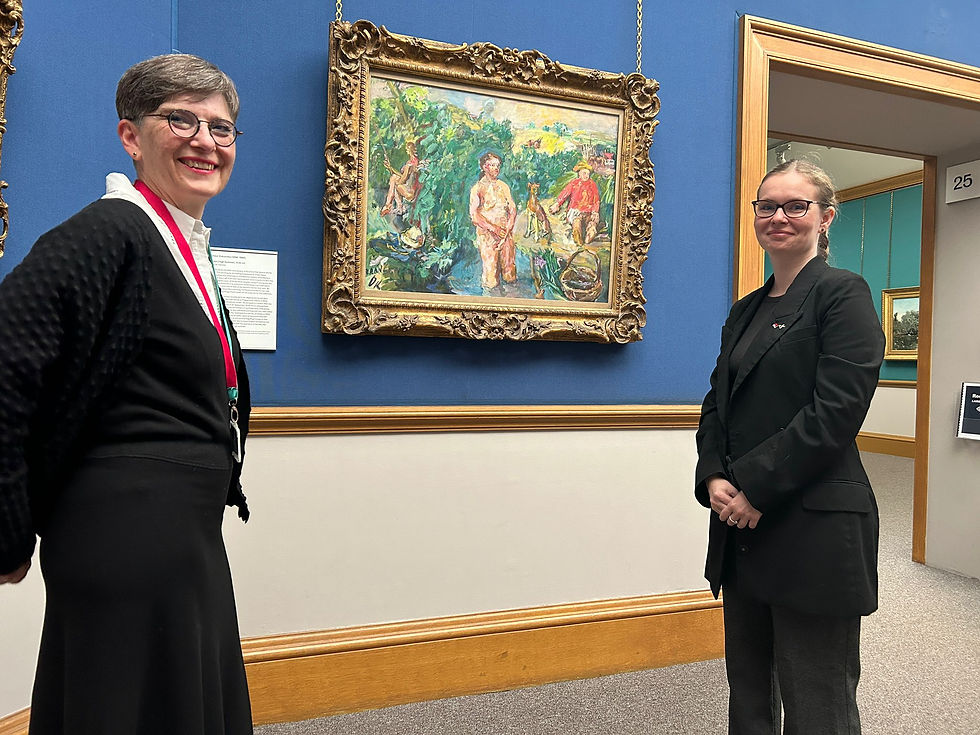
VE Day 80th Anniversary
At the National Galleries of Scotland in central Edinburgh, the Honorary Consul of the Czech Republic Veronika Macleod and Deputy Lord Provost Lezley Marion Cameron gathered to commemorate the 80th anniversary of the end of World War II in Europe.
Several months ago, Veronika Macleod requested if Dr. Patricia Allerston, Deputy Director and Chief Curator of the gallery, would display the painting High Summer (Zrání) by Oskar Kokoschka.
This painting was a Gift to Scotland. A gesture of gratitude for its hospitality towards Czechoslovak soldiers, artists, and civilians. Dr. Juraj Slávik, on behalf of the Czechoslovak government in exile, delivered Kokoschka’s Zrání (High Summer), presenting it to a representative of the country and in presence of Lord Provost of Edinburgh in an official ceremony on April 30, 1942. The Gallery once again showed great openness and, for the first time, accepted a painting from a living artist. Kokoschka who escaped to England in 1938, himself stayed and created in Scotland several times.
Over 6,000 Czechoslovak soldiers and airmen also arrived to Britain in WWII and fought alongside British forces and Allies against the Nazis, stationed across various units throughout the country. Scotland was their dream destination for short leave, offering much-needed respite. Therefore in 1940, Robert Smith founded the wartime charity Scottish Committee for the Welfare of Czechoslovak Troops in Great Britain. With the help of Lumír Soukup and many volunteers, they sought out Scottish families willing to welcome soldiers into their homes for Christmas, correspond with them, or send them woollen clothes and gifts. Hundreds of Czechoslovak airmen and soldiers were ‘adopted’ by Scottish families across the country. The initiative was carried out under the patronage of the Lord Provosts of Edinburgh and Glasgow. Financial support provided also the British Council and helped with organisation of many exhibitions and concerts across Scotland. One of the largest exhibitions about Czechoslovakia in the National Gallery took place in 1942.
To accommodate more soldiers, Lumír Soukup rented a large house in Edinburgh which was officially opened in 1941 by President Beneš as the Scottish-Czechoslovak House. Here, the painting High Summer (Zrání) hung for three years because, during the war, paintings from the National Gallery were stored in various locations for security reasons.
Now this symbol of our shared history from WWII will be exhibited in the National Gallery in room number 26, in the Impressionism section until the end of September.
The Honorary Consul Veronika Macleod will also give a lecture at the European Movement event on the occasion of the 80th anniversary, as part of the Festival of Europe, and will host a commemorative event at the Edinburgh City Chambers with Lord Provost Robert Aldridge and families of Czechoslovak veterans living in Scotland. (historical information was researched in archive by Veronika Macleod)
Dr Patricia Allerston: "Painting Zrání was displayed in the National Gallery in March 1942. It was on display at the Czechoslovak House when that was formally opened by President Benes in late 1942 and stayed on special loan there until the house closed in 1945. I don't think it was hung at the National Gallery in 1946, although it is in the 1946 catalogue. It then went to a Kokoschka exhibition in Amsterdam in 1947 and stayed there until 1948. It is in the 1957 catalogue of the National Gallery. It would have been transferred to our new Gallery of Modern Art when that opened in 1960. Our digital records start in 1993 and they show it was regularly displayed at the Gallery of Modern Art, but also frequently requested for international loan - to Tokyo, Bielefield, Vienna, Zurich, Prague, Regensburg, New Zealand, Australia, Bilbao and Paris (last 2022-23)."
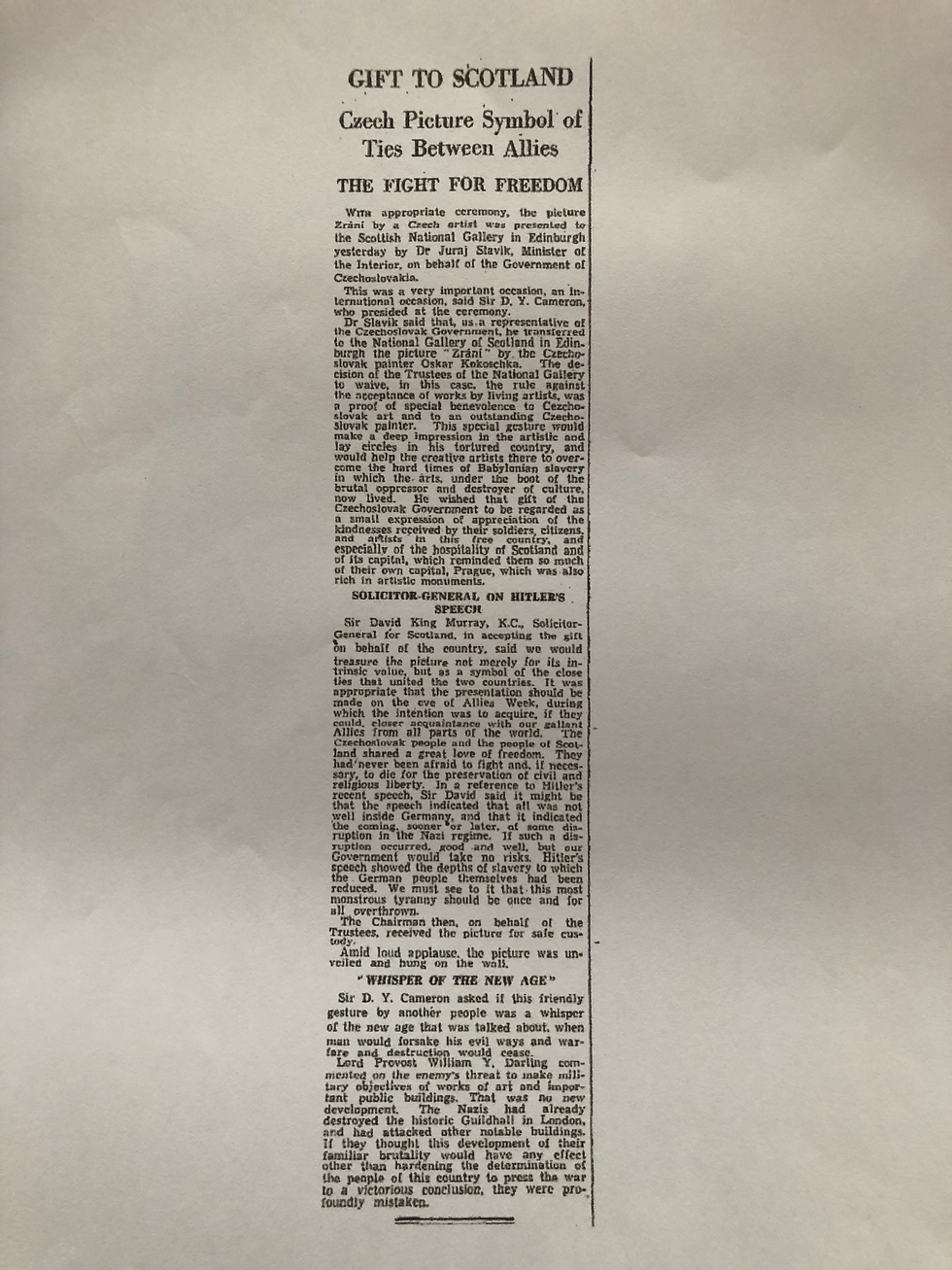
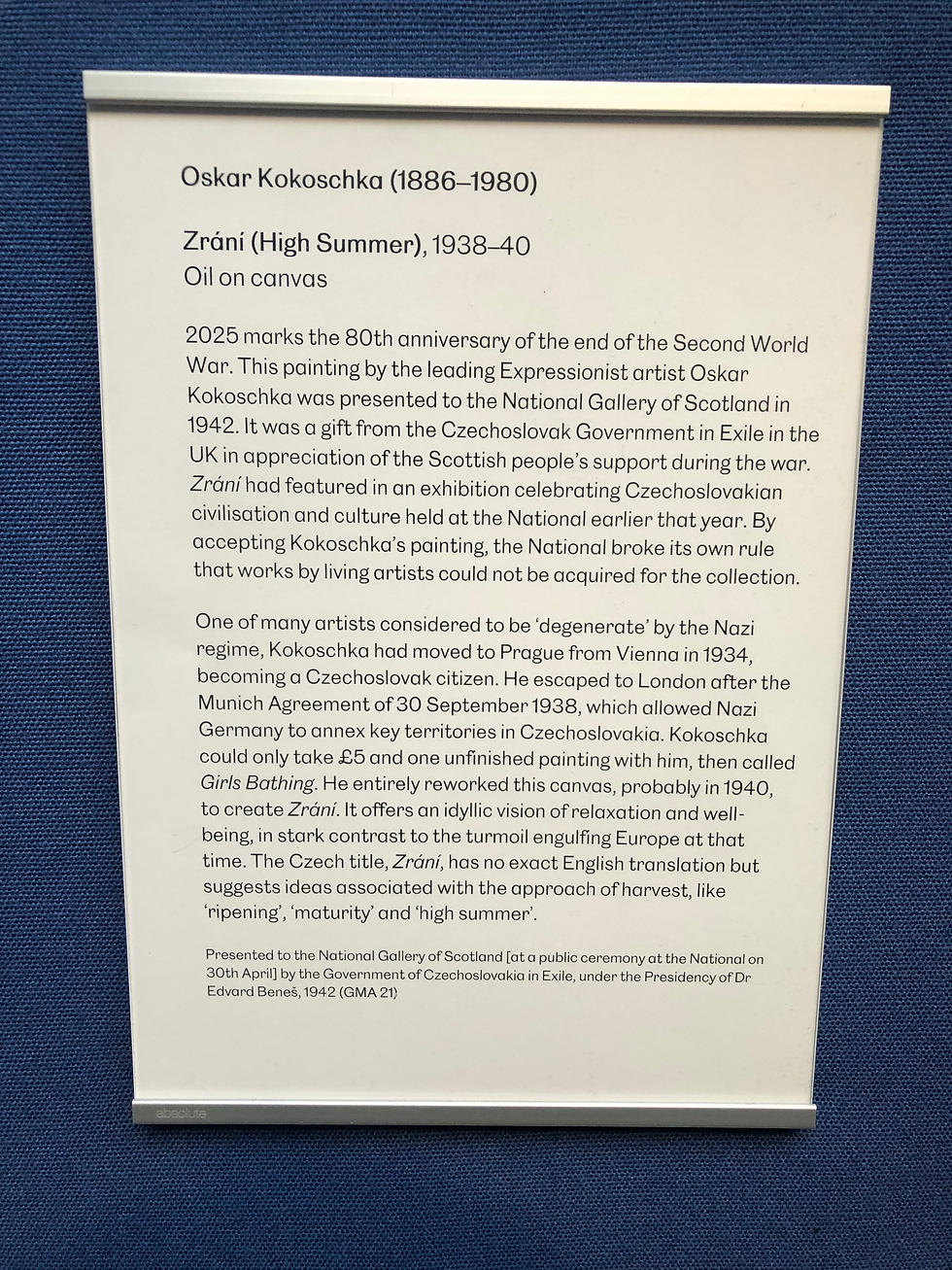
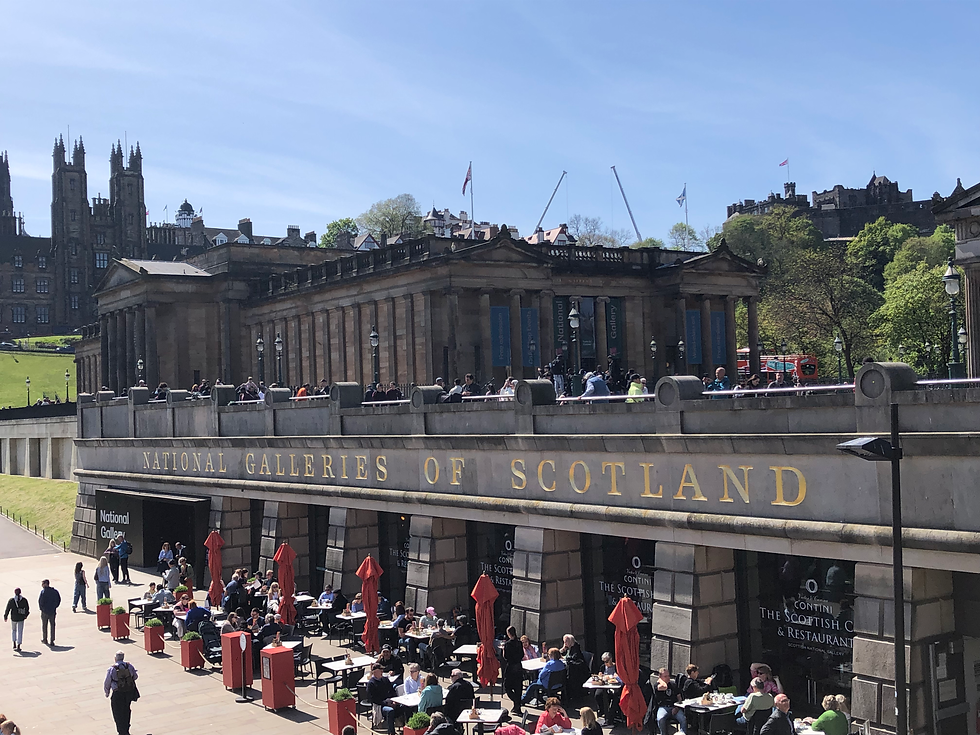








Comments